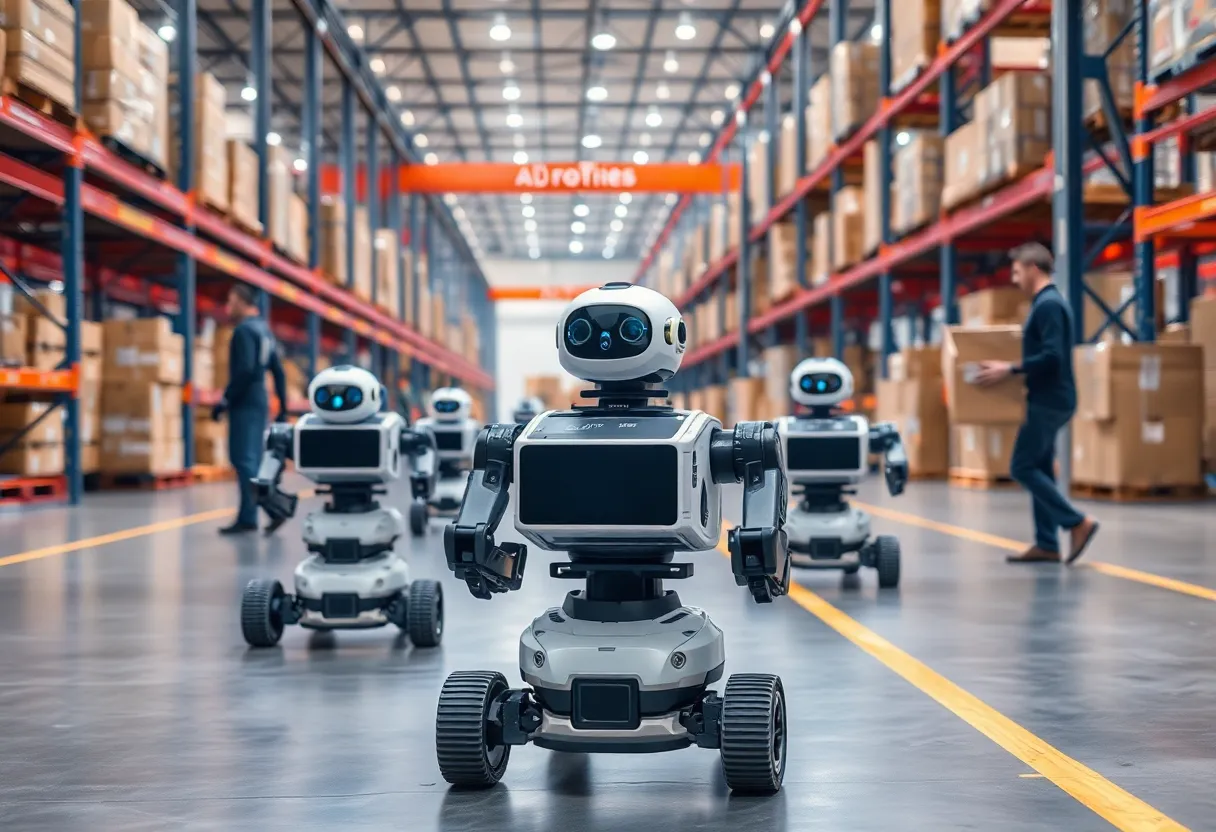Singapore, August 30, 2025
News Summary
The CEO of Kinisi Robotics highlighted key challenges in warehouse automation during a podcast, focusing on navigation and integration of autonomous robots with existing systems. Industry strategies are evolving to enhance robot efficiency and adaptability in complex logistics environments. Notable advancements in humanoid robotics were also discussed, along with significant funding for developing new technologies and the emerging importance of Singapore in the robotics sector.
Singapore
Kinisi Robotics CEO Identifies Integration and Navigation as Key Barriers to Warehouse Automation
The CEO and founder of Kinisi Robotics appeared on Episode 209 of The Robot Report Podcast to outline current challenges and innovations in deploying autonomous robots within warehouse environments. The discussion emphasized that the most urgent issues are navigating complex logistics and integrating autonomous systems with existing warehouse software and workflows. Industry leaders are pursuing new strategies to overcome these barriers, enabling more automated and efficient operations across distribution centers.
Who, what and why it matters
The podcast conversation centered on how autonomous mobile robots (AMRs) and manipulation systems must operate reliably in dynamic, cluttered warehouse settings and interface with inventory management and order processing systems. Companies are focusing on improving perception, motion coordination, and software integration so robots can work alongside humans, adapt to changing layouts, and carry out diverse tasks without extensive reprogramming. Progress in these areas could accelerate adoption of automation that raises throughput and reduces manual labor for routine tasks.
Supporting industry developments
Several broader industry updates illustrate parallel progress in robotics technology and investment. Boston Dynamics has highlighted the technical breadth required for humanoid robots, noting that such machines must handle both delicate and heavy items, maintain balance, coordinate complex movements, and adapt to unexpected situations. The company views development of AI generalist robots as essential for scaling humanoid automation. Work on large behavior models (LBMs) for Boston Dynamics’ Atlas humanoid has advanced through a collaboration with the Toyota Research Institute, indicating a move toward more versatile control and decision-making capabilities.
Funding and research efforts aimed at locomotion, manipulation, and uncertainty handling have also received notable support. FieldAI raised a combined $405 million across two funding rounds to drive global expansion and product development, including Field Foundation Models (FFMs) designed to handle physical constraints and real-world uncertainty in robotic systems.
Events and competitive benchmarks
The inaugural World Humanoid Games in China offered a public view of capabilities and limitations. Unitree won multiple events, including an autonomous 100-meter dash that was affected by a handicap rule. The Galbot robot emerged victorious in a warehouse sorting challenge, although that competition drew less public excitement than racing and boxing events. Organizers formed a new committee to ensure the event continues, indicating interest in making humanoid competitions a recurring venue for benchmarking progress.
Singapore’s growing role in robotics and manufacturing
Singapore was highlighted as a key manufacturing and robotics hub. The city-state is the world’s fifth-largest exporter of high-tech goods and has drawn investment interest from global manufacturers. Robotics companies are expanding local operations: a Singapore-based robotics software company raised $11 million in a Series A+ round to scale AI-driven robotic deployments using a no-code platform that simplifies programming for variable manufacturing tasks. Another robotics firm opened a larger facility in Singapore to support customer demand and showcase solutions.
Singapore’s high adoption rate of industrial robots is reflected in robot density figures of approximately 730 to 770 robots per 10,000 employees, second only to South Korea. This aligns with a broader global trend: the International Federation of Robotics reported a new global average robot density of 162 units per 10,000 employees in 2023, with marked increases in Asia.
What this means for warehouses and manufacturers
The combination of investment, competitive testing, and focused R&D suggests a two-track trajectory: incremental gains in AMR and manipulation technologies for warehouses, and longer-term efforts to create more generalist humanoid systems. For warehouse operators, the immediate payoff is in systems that reduce complexity for deployment—such as no-code programming platforms—and improved integration tools that allow robots to be added to existing workflows with fewer disruptions. For robotics developers, funding and collaborative research are enabling more sophisticated models for handling real-world constraints and multi-task behavior.
Background
Warehouse automation has evolved from fixed, single-task machinery toward flexible robots capable of navigation, perception, and manipulation. Challenges persist around safety, interaction with human workers, software compatibility, and task generalization. Humanoid robots introduce additional technical demands, including balance, coordinated motion, and diverse manipulation skills. Industry funding rounds, competitions, and concentrated manufacturing hubs like Singapore are shaping the pace and direction of these developments.
FAQ
What were the main topics discussed by Kinisi Robotics’ CEO?
The CEO discussed deployment challenges for autonomous warehouse robots, emphasizing navigation in complex logistics environments and integration with existing warehouse systems.
How are companies addressing integration and navigation challenges?
Approaches include improved perception and motion planning, tighter software integration with warehouse management systems, the use of no-code platforms to simplify programming, and development of models that handle real-world uncertainty.
What progress has been made on humanoid robots?
Work is underway to develop humanoid capabilities such as coordinated movement, balance, and versatile manipulation. Collaborations have advanced large behavior models for humanoids, and competitions like the World Humanoid Games are providing testbeds for performance and reliability.
Which companies and funding events were mentioned?
Key items include FieldAI raising $405 million to develop Field Foundation Models, a Singapore-based firm raising $11 million to scale a no-code robotics platform, and expansion activity from other robotics companies in Singapore.
Why is Singapore important in this context?
Singapore is a major exporter of high-tech goods, a growing manufacturing center, and a leading adopter of industrial robots, with high robot density and active investment in robotics companies and facilities.
Quick Reference Table
| Topic | Organization / Event | Key Facts | Implication |
|---|---|---|---|
| Warehouse automation discussion | Kinisi Robotics (CEO on podcast) | Focus on navigation and integration challenges for autonomous warehouse robots | Improved integration and navigation can speed adoption and efficiency |
| Humanoid development | Boston Dynamics / Toyota Research Institute | Need for versatile manipulation, balance, coordinated movement; progress on large behavior models for Atlas | Advances could enable more generalist humanoid robots over time |
| Funding for locomotion & manipulation | FieldAI | $405 million raised in two rounds; building Field Foundation Models for uncertainty and constraints | Increases capacity to develop robust field-capable robots |
| Humanoid competitions | World Humanoid Games (China) | Unitree won multiple events; Galbot won warehouse sorting; organizing committee formed | Competitions offer benchmarking and public visibility for progress |
| Robotics software funding | Augmentus (Singapore) | $11 million Series A+; no-code platform; 50+ systems sold across six countries | No-code tools lower barriers for automation in high-mix manufacturing |
| Regional manufacturing hub | Singapore | 5th-largest exporter of high-tech goods; robot density ~730–770 per 10,000 employees | Strong foundation for industrial automation and robotics deployment |
| Global robot density | International Federation of Robotics | Record global average of 162 robots per 10,000 employees in 2023 | Indicates rising global automation, especially in Asia |
Deeper Dive: News & Info About This Topic
HERE Resources
Amazon to Launch Humanoid Park for Delivery Robot Testing
Rockwell Automation Invests in RightHand Robotics
Additional Resources
- CNN: Singapore’s Hyundai Robot Dog
- Crowdfund Insider: Augmentus Raises $11M
- The Robot Report: Flexiv Expands in Singapore
- Engineering.com: Robot Adoption Hits New Record
- Visual Capitalist: Countries with Most Industrial Robots
- Wikipedia: Robotics
- Google Search: Robotics
- Google Scholar: Robotics
- Encyclopedia Britannica: Robotics
- Google News: Robotics

Author: STAFF HERE BOSTON WRITER
The BOSTON STAFF WRITER represents the experienced team at HEREBoston.com, your go-to source for actionable local news and information in Boston, Suffolk County, and beyond. Specializing in "news you can use," we cover essential topics like product reviews for personal and business needs, local business directories, politics, real estate trends, neighborhood insights, and state news affecting the area—with deep expertise drawn from years of dedicated reporting and strong community input, including local press releases and business updates. We deliver top reporting on high-value events such as Boston Marathon, Head of the Charles Regatta, and Boston Harborfest. Our coverage extends to key organizations like the Greater Boston Chamber of Commerce and Associated Industries of Massachusetts, plus leading businesses in finance, biotech, and insurance that power the local economy such as Fidelity Investments, Biogen, and Liberty Mutual Insurance. As part of the broader HERE network, we provide comprehensive, credible insights into Massachusetts's dynamic landscape.





